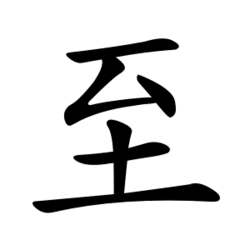Radical 133
| 至 | ||
|---|---|---|
| ||
| 至 (U+81F3) "arrive" | ||
| Pronunciations | ||
| Pinyin: | zhì | |
| Bopomofo: | ㄓˋ | |
| Gwoyeu Romatzyh: | jyh | |
| Wade–Giles: | chih4 | |
| Cantonese Yale: | ji | |
| Jyutping: | zi3 | |
| Japanese Kana: | シ shi (on'yomi) いた-る ita-ru (kun'yomi) | |
| Sino-Korean: | 지 ji | |
| Names | ||
| Japanese name(s): | 至/いたる itaru (Left) 至偏/いたるへん itaruhen | |
| Hangul: | 이를 ireul | |
| Stroke order animation | ||
 | ||
Radical 133 or radical arrive (至部) meaning "arrive" or "most" is one of the 29 Kangxi radicals (214 radicals in total) composed of 6 strokes.
In the Kangxi Dictionary, there are 24 characters (out of 49,030) to be found under this radical.
至 is also the 129 indexing component in the Table of Indexing Chinese Character Components predominantly adopted by Simplified Chinese dictionaries published in mainland China.
Evolution
-
 Oracle bone script character
Oracle bone script character -
 Bronze script character
Bronze script character -
 Large seal script character
Large seal script character -
 Small seal script character
Small seal script character
Derived characters
| Strokes | Characters |
|---|---|
| +0 | 至 |
| +4 | 致 |
| +6 | 臵 臶 臷 臸 |
| +7 | 臹 |
| +8 | 臺 |
| +10 | 臻 |
Sinogram
The radical is also used as an independent Chinese character. It is one of the Kyōiku kanji or Kanji taught in elementary school in Japan.[1] It is a fifth grade kanji.[1]
References
- ^ a b "The Kyoiku Kanji (教育漢字) - Kanshudo". www.kanshudo.com. Archived from the original on March 24, 2022. Retrieved 2023-05-06.
Literature
- Fazzioli, Edoardo (1987). Chinese calligraphy : from pictograph to ideogram : the history of 214 essential Chinese/Japanese characters. calligraphy by Rebecca Hon Ko. New York: Abbeville Press. ISBN 0-89659-774-1.
External links
Wikimedia Commons has media related to Radical 133.